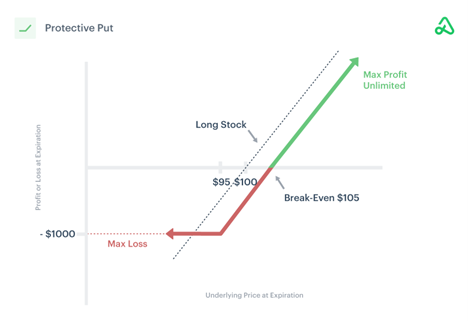Increasingly more advisors and investors are discovering the benefits of options strategies in their portfolios. There is great value in understanding and utilizing options strategies with the range of benefits they can provide portfolios, including protective puts.
Options strategies can mitigate volatility, enhance income, and limit losses, depending on the options used and their deployment in portfolios. Covered call ETFs tend to garner the most attention and investor allocation, but protective put strategies also have their place and are a great way to protect against losses and uncertainty.
See also: “Know your Options: Covered Calls”
What Is a Protective Put?
A protective put entails holding an underlying security while also buying a put option at a premium on the underlying assets. The holder of the put can sell the underlying security at a strike price on a specific date. They can exercise the put at any point up until expiration, and the protective put limits any losses below the strike price. Those that purchase the protective put carry no obligation to exercise it.
Protective puts protect against downturns and function more like an insurance policy for the underlying securities. They’re great for when market outlooks in the near term appear bearish. They also are good in uncertain or volatile markets since they mitigate losses beyond the strike price. Protective puts can provide a strong hedge against market-wide or asset-specific risk.
Unlike covered calls, protective puts do not limit any upside potential of the underlying securities. The buyer of the protective put is out the premium and therefore needs the underlying asset to cross above both the initial cost and the added cost of the premium to break even.

Image source: Option Alpha
Deploying Protective Puts in Strategies
Protective puts provide a number of benefits through a variety of options strategies. While it’s not uncommon to use protective puts in a straightforward manner, they’re also used in ladders and spreads in various in-the-money and out-of-the-money positions. A long put ladder limits profit potential and provides maximum benefit when volatility expectations remain minimal. A short put ladder limits downside risk and is most profitable when markets plummet.
Advisors and investors looking to capitalize on protective put strategies and increase income potential should consider the NEOS Enhanced Income Aggregate Bond ETF (BNDI) and the NEOS Enhanced Income Cash Alternative ETF (CSHI).
BNDI invests in the Vanguard Total Bond Market ETF (BND) and the iShares Core U.S. Aggregate Bond ETF (AGG). The income and capital gains BNDI receives from its bond allocations are enhanced by adding monthly income from the fund’s put-option strategy on the S&P 500. The strategy includes selling short puts and buying long puts to protect against volatility. The fund has a management fee of 0.58%.
CSHI is an actively managed ETF that generates high monthly income and is an options-based fund. CSHI is long on three-month Treasuries and also sells out-of-the-money SPX Index put spreads. These roll weekly to account for market changes and volatility. The fund has a management fee of 0.38%.
Both funds seek to take advantage of tax-loss harvesting opportunities and the tax efficiency of index options. The put options that the fund uses are not ETF options but instead are S&P 500 index options. These options receive favorable taxation rates as Section 1256 Contracts under IRS rules. Any capital gains or losses are taxed as 60% long-term and 40% short-term. These rates hold no matter how long the investor owned the options and can offer noteworthy tax advantages.
For more news, information, and analysis, visit the Tax-Efficient Income Channel.

